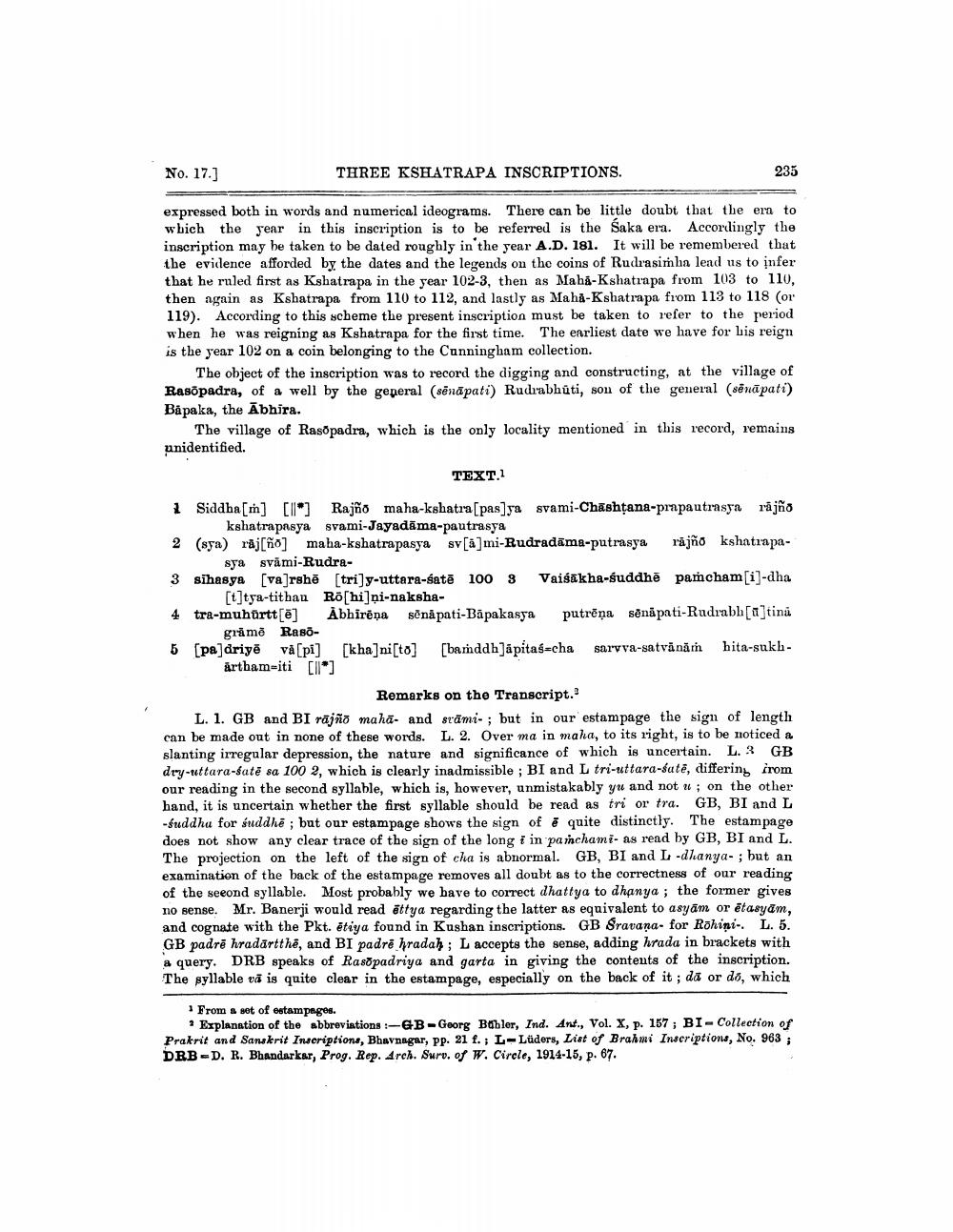________________
No. 17.]
THREE KSHATRAPA INSCRIPTIONS.
235
expressed both in words and numerical ideograms. There can be little doubt that the era to which the year in this inscription is to be referred is the Saka era. Accordingly the inscription may be taken to be dated roughly in the year A.D. 181. It will be remembered that the evidence afforded by the dates and the legends on the coins of Rudrasimha lead us to įnfer that he ruled first as Kshatrapa in the year 102-3, then as Mahi-Kshatrapa from 103 to 110, then again as Kshatrapa from 110 to 112, and lastly as Mahå-Kshatrapa from 113 to 118 (or 119). According to this scheme the present inscription must be taken to refer to the period when he was reigning as Kshatrapa for the first time. The earliest date we have for his reign is the year 102 on a coin belonging to the Cunningham collection.
The object of the inscription was to record the digging and constructing, at the village of Rasopadra, of a well by the general (sēnāpati) Rudrabhuti, son of the general (sēnāpati) Båpaka, the Abhira.
The village of Raspadra, which is the only locality mentioned in this record, remains unidentified.
TEXT.1
1 Siddha[m] [ll] Rajño maha-kshatra (pas]ya svami-Chashtana-prapautrasya rājño
kshatrapasya svami-Jayadāma-pautrasya 2 (sya) raj[no] maha-kshatrapasya sy[á]mi-Rudradāma-putrasya răjño kshatrapa
sya svāmi-Rudra3 sihasya [va]rshē (tri]y-uttara-satē 100 3 Vaisakha-suddhē pamcham[i]-dha
[t]tya-tithau Ro[hi]ņi-naksha4 tra-muhürtt[@] Abhirona sinapati-Bāpakasya putröna sēnā pati-Rudrabh[n]tina
grāmē Rabo5 (pa]driyē và[pi] [kha]nisto] [bamddh]ápitaś=cha sarvva-satvānăm hita-sukhártham=iti [ll]
Remarks on the Transcript.? L. 1. GB and BI rājño mahā- and srāmi- ; but in our estampage the sign of length can be made out in none of these words. L. 2. Over ma in maha, to its right, is to be noticed a slanting irregular depression, the nature and significance of which is uncertain. L. 3 GB dry-uttara-sate sa 100 2, which is clearly inadmissible ; BI and L tri-uttara-sate, differing from our reading in the second syllable, which is, however, unmistakably yu and not ; on the other hand, it is uncertain whether the first syllable should be read as tri or tra. GB, BI and L -fuddhu for suddhē; but our estampage shows the sign of ē quite distinctly. The estampage does not show any clear trace of the sign of the long i in panchami- as read by GB, BI and L. The projection on the left of the sign of cha is abnormal. GB, BI and L-dhanya- ; but an examination of the back of the estampage removes all doubt as to the correctness of our reading of the seeond syllable. Most probably we have to correct dhattya to dhanya; the former gives no sense. Mr. Banerji would read attya regarding the latter as equivalent to asyām or ētasyam, and cognate with the Pkt. ētiya found in Kushan inscriptions. GB Sravana- for Rõhiņi. L. 5. GB padrē hradārtthē, and BI padre hradah; L accepts the sense, adding hrada in brackets with a query. DRB speaks of Raspadriya and garta in giving the contents of the inscription. The syllable vă is quite clear in the estampage, especially on the back of it ; da or do, which
From a set of estampages.
* Explanation of the abbreviations :-GB-Georg Bahler, Ind. Ant., Vol. X, p. 157; BI- Collection of Prakrit and Sanskrit Inscriptions, Bhavnagar, pp. 21 f.; L-Lüders, List of Brahmi Inscriptions, No. 963 DRB-D. R. Bhandarkar, Prog. Rep. Arch. Surv. of W. Cirole, 1914-15, p. 67.




